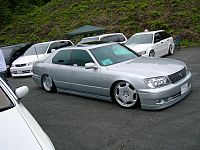| Revision as of 00:11, 22 February 2022 editTKOIII (talk | contribs)Extended confirmed users18,028 editsm more minor stuffTag: Visual edit← Previous edit | Revision as of 00:12, 22 February 2022 edit undoTKOIII (talk | contribs)Extended confirmed users18,028 edits ditched the tags because there are plenty of sources to establish relevance of the term and there are now a number of citations on the article as wellTag: Visual editNext edit → | ||
| Line 1: | Line 1: | ||
| {{multiple issues| | |||
| {{notability|Neologisms|date=February 2011}} | |||
| {{refimprove|date=August 2012}} | |||
| }} | |||
| ] with VIP style modifications]] | ] with VIP style modifications]] | ||
| ] | ] | ||
Revision as of 00:12, 22 February 2022




VIP style (Template:Lang-ja) is a car modification trend that translates from the Romanised Japanese term 'bippu.' It refers to the modification of Japanese luxury automobiles to make them lower and wider in stance, with more aggressive wheels, suspension, and body kits. VIP Style cars are typically large, rear-wheel drive luxury sedans, although automotive enthusiasts sometimes use other cars such as minivans or kei cars.
VIP cars were once associated with the Yakuza; however, VIP style modifications are now a subset of their own as automotive modifications. As a trend, it differentiates itself from the traditional origins of the term VIP otherwise associated with the concept of a "very important person".
The VIP style has become a loose appropriation of the term perpetuated amongst enthusiasts that goes beyond traditional VIP cars.
History
VIP modifications and their history have often been linked to the Yakuza. By using JDM cars with modifications associated with limousines, gangsters could avoid detection by the police and rival gangs.
Both Osaka street racers and Kanto-area bōsōzoku gangs adopted styles in different ways. Osaka street racers, after suffering numerous police crackdowns on the Hanshin Expressway in the early 1990s, turned to sedans, after police targeted sport compacts, as a way to cruise while remaining incognito. The bōsōzoku in Kanto took a somewhat different approach by modifying sedans with cut coils and mufflers. The resulting cars were often bold and loud and known as "Yankee Style". Their styling cues were actually taken from Super Silhouette race cars of the 1970s and 1980s. They also drove recklessly, such as causing traffic jams and avoiding paying tolls. To mimic their Yakuza counterparts, they used large black sedans.
Characteristics
Common exterior modifications on VIP style cars include modified suspension to achieve a lowered ride height, typically using coilovers or air suspension, and often also modified or custom control arms, suspension knuckles, tie rods and more; 3 piece wheels, often in wide configurations with low offsets that sit flush with the fenders or tuck inside of them; modified exhausts; LED lighting; upgraded larger brakes; and body kits, which can range from simple lip kits or fender flares to more extensive custom widebody setups. It is not uncommon to see significant negative camber on many VIP style cars. Common interior modifications on VIP style cars include custom upholstery (most commonly leather), window curtains, headrest pillows, seat cushions, tray tables, upgraded stereo systems, storage for champagne flutes and alcoholic drinks, chandeliers, starlight headliners, and more. Traditional VIP style colours are black, white, grey and silver, however, as the style has evolved, many builders have also embraced more bright and flashy colors as well.
The appearance of these vehicles is regarded in Japan as conspicuous and attention-seeking, as owning this type of vehicle is expensive with regards to Japan's annual road taxes.
Cars used
The majority of VIP cars are luxury sedans from Japanese automakers such as the Nissan Cedric/Gloria/Fuga, Cima/President, Leopard/Laurel, Nissan Cefiro from Nissan, the Toyota Aristo, Celsior, Century, Crown Majesta, Toyota Windom Mark X and Crown from Toyota, the Mitsubishi Proudia/Dignity, Diamante/Magna from Mitsubishi, the Mazda Sentia/929/Luce, Millenia, MS-8 from Mazda and the Honda Legend, Vigor/Inspire from Honda. As automotive enthusiasts began to put their own spin on VIP, everything from minivans like the Toyota Estima and Honda Odyssey, to smaller cars like the Suzuki Cappucino and Toyota bB, have received similar modifications.
United States enthusiasts often use USDM Japanese sedans, such as the Lexus GS, Lexus LS, Infiniti Q45, Infiniti M45, and Acura RL.
Some of the most common brands associated with VIP style modifications include Junction Produce, Aimgain, Impul, Wald, T-Demand, Mode Parfume, Garson, K-Break, Vipdout, Ulterior Motives, 326Power, Fabulous, Black Pearl Complete, Job Design, J-Unit and Vlene.
Notes
- Scott Tsuneishi, Keepin' it Gangsta Homie-san, Import Tuner, December 2006 (#93).
- "Japanese Big Sedan Tuning - What Are VIP Cars?". MotorTrend. 2020-06-22. Retrieved 2022-02-21.
- "Then & Now: The Evolution of American VIP Style". DrivingLine. Retrieved 2022-02-21.
- "Being A VIP At TAS". Speedhunters. 2014-01-16. Retrieved 2022-02-22.